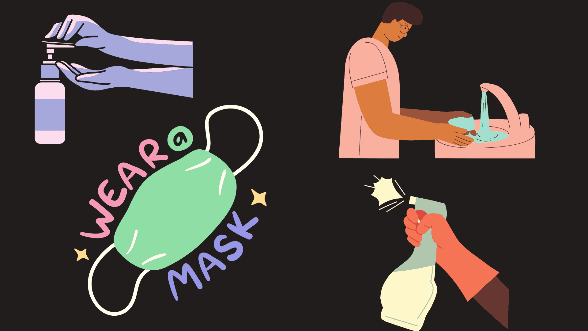Previously it was scarce to see a person wearing a mask other than medical staff. During this pandemic, the mask, which is made up of nonwoven material, has penetrated the general public just because it acts as a barrier against foreign substances. According to WHO guidelines, the preventive measures for the COVID-19 pandemic are washing hands frequently, practicing respiratory hygiene by wearing a mask, maintaining social distancing. Other measures include avoiding touching eyes, nose, and mouth and avoiding raw or undercooked animal products.
which is made up of nonwoven material, has penetrated the general public just because it acts as a barrier against foreign substances. According to WHO guidelines, the preventive measures for the COVID-19 pandemic are washing hands frequently, practicing respiratory hygiene by wearing a mask, maintaining social distancing. Other measures include avoiding touching eyes, nose, and mouth and avoiding raw or undercooked animal products.
By wearing only, the facemask, individuals cannot be able to arrest the attack of virus. But this is one of the preventive measures to protect the individual from the attack of germs. Therefore, the demand for masks has achieved its peak nowadays. The unescapable spread of the deadly virus COVID-19 has sent the public scrambling for face masks to the extent that there is a severe scarcity of items. Thus, companies are working tirelessly to meet rising demand.
A brief introduction to nonwoven fabric
Nonwoven fabrics are defined as “sheet or web structures bonded together by entangling fiber or filaments mechanically, thermally or chemically. These are flat sheets made directly from separate fibers/from molten plastic/plastic film”. When the textiles serve any specific function, then they are termed functional textiles. Thus they must have some advantages over the others to serve the specific purpose.
 Therefore, nonwoven has various advantages to serve in this fragile sector of medical textiles. It is lightweight with a fluffy and good feel, soft and comfortable. It is also water repellant, air permeable, non-toxic, non-irritant with excellent and non-directional strength, made up of antibacterial agents, and antibacterial itself.
Therefore, nonwoven has various advantages to serve in this fragile sector of medical textiles. It is lightweight with a fluffy and good feel, soft and comfortable. It is also water repellant, air permeable, non-toxic, non-irritant with excellent and non-directional strength, made up of antibacterial agents, and antibacterial itself.
So, coming back to the demand for nonwoven nowadays, it is increasing day by day. It is not the fact that the demand for nonwoven is increasing in only this scenario. Non-woven are getting popularity previously also. But COVID-19 acts as a stimulus for nonwoven. So, the government must meet the demand for a facemask to fight against the deadly virus we encountered uninvitedly.

India’s young population must learn something from the aging Japanese population regarding mask culture. Japanese had adapted the mask culture after the outbreak of the Spanish flu pandemic in 1918. They usually wear it throughout the year. In winter, to prevent the spread of colds and flu, and in spring and allergy season, to protect against pollen.
So, it is evident that if this kind of culture is prevalent among the population, the demand will increase so will the production. Thus, creating more employment, and this, to some extent, we could protect ourselves from various germs and other unwanted foreign particles. This is a continuous process, not of days or months, or years. Therefore, we need to work continuously to overcome this shortfall.
Author:
POOJA SINGH
Assistant Professor,
Faculty of Fashion & Design, SGT University

